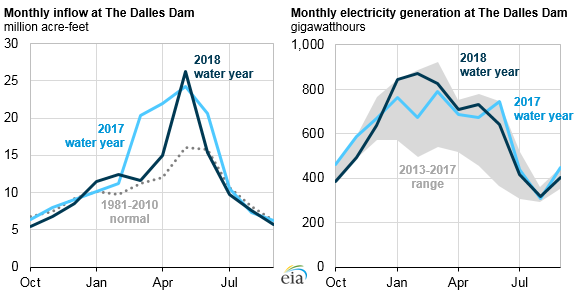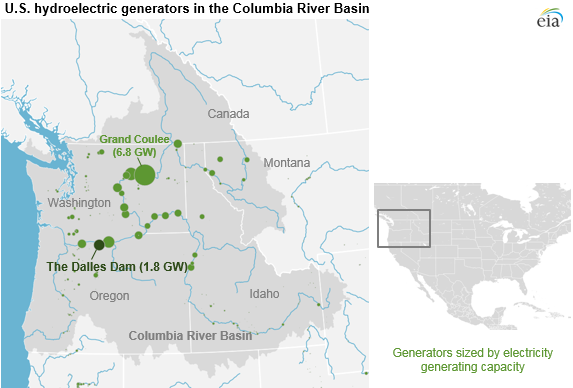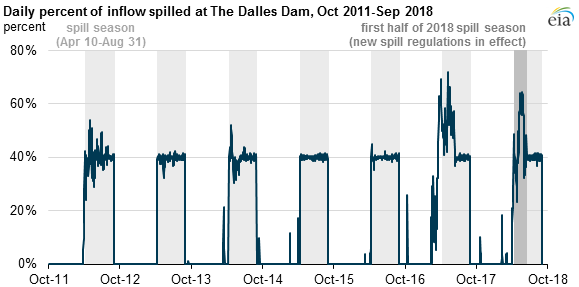During the 2018 water year that ends September 30, 2018, The Dalles Dam in the Pacific Northwest experienced above-normal inflow—water volume flowing into the dam—but electricity generation from the dam remained relatively normal. The difference between the two is attributed to spilled flow, or water diverted past the dam without generating power. Monthly inflow at The Dalles Dam peaked in May, reaching 63% above normal, but more than half of that volume was spilled, some of which was likely required by a recent court order.

Because of its location near the Columbia River mouth, conditions at The Dalles Dam reflect the entire upstream Columbia River system and its many hydroelectric dams. Higher-than-normal inflow at The Dalles Dam typically signifies a wetter-than-normal water year in the Pacific Northwest region. In the past decade, hydroelectricity has accounted for 62% to 77% of the annual electricity generated in Washington, Oregon, and Idaho.

Even after this modulation, the 2018 water year saw high springtime inflow at The Dalles Dam because of below-normal temperatures and above-normal precipitation last winter, followed by rapid warming in May. According to USACE, monthly flow volumes at The Dalles Dam this spring ranged from 4% to 63% above normal values established by averaging flows from 1981 through 2010. The total flow through The Dalles Dam during the 2018 water year (October 2017–September 2018) will be 10% above normal.
Although snowpack runoff in the Pacific Northwest typically peaks in May, year-to-year variations in weather can affect the timing of the melt onset and peak river flow. The 2017 water year (October 2016 through September 2017) saw high inflows because of unusually high precipitation in February and March 2017.
Water can be diverted around a hydroelectric plant’s turbines, and, depending on the reason for the diversion, is considered voluntary or involuntary spill. Voluntary spill is required by law at some dams to protect marine wildlife. Involuntary spill is an operational decision that occurs at any dam when its plant must pass water downstream in excess of its turbine capacity, usually because of significantly high inflows. The 2018 water year experienced both types of spill, and a new court order in effect for this water year likely increased the voluntary spill at The Dalles Dam.
During the spill season, which lasts from April 10 through August 31, The Dalles Dam must voluntarily spill some of the water that passes through the dam to facilitate fish passage. The required amount had been set at 40% of inflow; however, beginning with the 2018 water year, USACE’s Fish Passage Plan changed the required spill levels for the first half of the spill season, which ended June 15.
During the first half of the spill season, The Dalles Dam must spill the maximum amount deemed safe for fish, based on measurements of total dissolved gas in the water. Spilled water is beneficial because it allows fish to pass by a dam without going through its turbines. However, spilling water over dams makes the water more turbulent, and the extra air bubbles in the water can make fish respiration challenging. The requirement for the second half of spill season remained at 40% of inflow.

Principal contributors: Michelle Bowman, Greg Lawson

Follow us on social media: